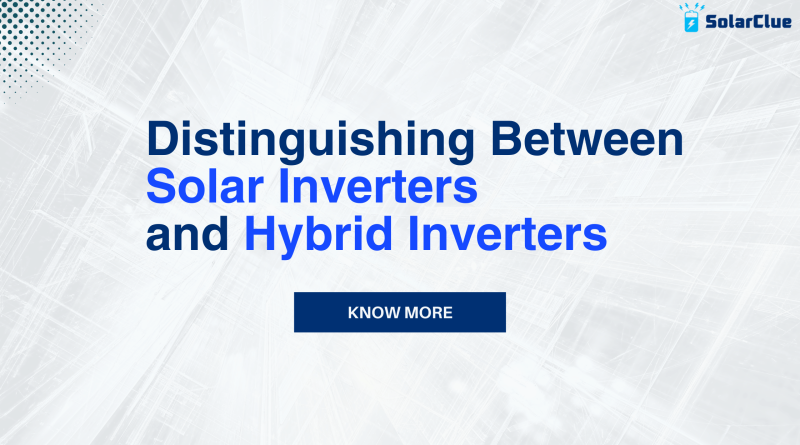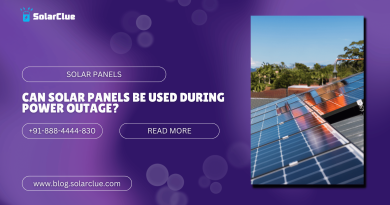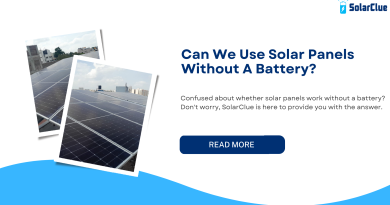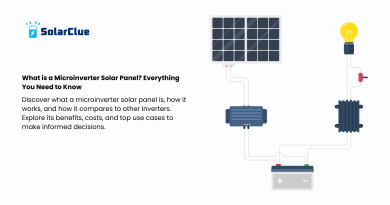Difference between Solar Inverters and Hybrid Inverters
Everyone will be in a dilemma as to whether to opt for a solar inverter or a hybrid inverter. In this blog, let’s dive into the fascinating world of solar and hybrid inverters. The increasing need for alternative energy sources and knowing the critical differences between these two types of inverters are essential.
Table of Contents
Solar Inverter
Solar inverters are an essential part of a solar power system. Their primary responsibility is to change the solar panels’ direct current (DC) into alternating current (AC), which can power buildings, commercial establishments, and other electrical appliances. Solar inverters play a crucial role in maximising the effectiveness of solar energy and ensuring that it can be used efficiently.
Here are some important aspects and features of solar inverters:
Converting DC to AC:
Solar panels generate electricity through direct current (DC). However, most electrical appliances and the power grid operate on alternating current (AC). Solar inverters perform the crucial conversion by converting captured DC power into AC power that can be used immediately or fed back into the grid.
MPPT technology:
Many solar inverters are equipped with Maximum Power Point Tracking (MPPT) technology. MPPT technology optimizes the energy output of the solar panels by continuously tracking and adjusting the voltage and current to maximize efficiency. This ensures that the inverter operates at the maximum power point of the solar modules, even in changing weather conditions.
Grid-tied inverters:
Solar installations for homes and businesses most frequently employ grid-tied (grid-connected) inverters. The purpose of these inverters is to synchronize generated power with the grid. Depending on local laws, extra electricity can be returned to the grid and rewarded through net metering programs or feed-in tariffs.
String Inverters:
In solar installations where multiple solar modules are connected in series to form a string, operators commonly use string inverters. These inverters connect to the entire line and collectively convert DC electricity to AC electricity. String inverters are inexpensive, reliable, and suitable for systems with uniform solar module orientation and shading.
Micro-inverters:
Micro-inverters are an alternative to string inverters. Unlike string inverters, micro-inverters are installed on each solar module. This allows for more precise control and optimisation of each module’s output. Microinverters are ideal for systems with shading issues or differently oriented modules, as they mitigate the impact of underperforming modules on overall system efficiency.
Monitoring and data analysis:
Many modern solar inverters have built-in monitoring systems that allow users to track system performance and energy production and troubleshoot any problems. Some inverters can be connected to online platforms or mobile apps that provide real-time data and insights into energy production and consumption.
Efficiency and longevity:
Solar inverters have a high-efficiency rating, typically between 95% and 98%. This means they can convert much of the captured solar energy into usable electricity. Inverters also undergo rigorous testing to ensure their longevity and reliability under various environmental conditions, such as extreme temperatures and humidity.
Hybrid Inverters
On the other hand, hybrid inverters go beyond the traditional functions of a solar inverter. Hybrid inverters convert DC electricity to AC electricity and integrate energy storage systems such as batteries. This feature allows hybrid inverters to provide backup power during grid outages and optimize power consumption.
Hybrid inverters represent a significant advance in renewable energy systems and offer a game-changer in using solar energy. Hybrid inverters not only convert DC power from solar panels into usable AC power but also provide the ability to store energy, making them versatile and efficient solutions for residential and commercial applications. Let’s look in detail:
Energy storage integration:
The most crucial feature differentiating hybrid inverters from traditional solar inverters is their ability to integrate energy storage systems such as batteries. Solar panels capture, store, and use excess energy, creating a self-sufficient and reliable power source. Hybrid inverters control the flow of electricity between the solar modules, the batteries, and the power grid, optimising energy use and ensuring an uninterrupted power supply.
Backup power during grid outages:
One of the most significant advantages of hybrid inverters is their ability to provide backup power during grid outages. When energy storage systems are in place, hybrid inverters can seamlessly switch to battery power to keep critical equipment and systems running during grid outages. This makes hybrid inverters an attractive choice for areas with unreliable or unstable power grids, as they provide uninterrupted power and increase energy resilience.
Optimised energy consumption:
Hybrid inverters enable intelligent energy management, allowing users to optimise their energy consumption. You can store extra solar energy generated throughout the day in batteries and use it later, especially during periods of low solar radiation or high energy demand.This helps reduce dependence on the power grid and lowers energy costs, making hybrid inverters a financially viable option in the long run.
Peak load management and time-of-use tariffs:
Programmable hybrid inverters efficiently manage peak loads, reducing reliance on grid power during high-demand periods and cutting energy costs. They store surplus solar electricity during off-peak times and utilize it during high demand, strategically managing energy consumption in regions with time-of-use tariffs to benefit from lower electricity rates during specific periods.
Grid independence:
Hybrid inverters provide a degree of grid independence and energy autonomy. Homeowners and businesses can generate, store, and consume their electricity by combining solar panels and energy storage. This can lead to less dependence on the grid and greater energy self-sufficiency, ultimately providing greater control over energy costs and reducing the environmental impact of traditional fossil fuel power generation.
Scalability and flexibility:
Hybrid inverters are highly scalable and flexible solutions. They are simple to add to new installations or incorporate into already-existing solar systems.
In addition, the capacity of the energy storage system can be expanded as needed to meet changing energy demands. This scalability and flexibility make hybrid inverters suitable for various applications, from homes to commercial buildings to off-grid installations.
In summary, hybrid inverters represent a significant inflection point in renewable energy systems. Integrating energy storage capacity into solar inverters enables new ease of use, reliability, and grid independence. With backup power during grid outages, optimised energy consumption, and scalability, hybrid inverters offer a more comprehensive and adaptable solution for harnessing solar energy and transitioning to a more sustainable future.
Main Differences between Solar Inverters and Hybrid Inverters
a. Storage Capacity:
Solar inverters have no built-in energy storage capability. If available, they rely solely on the grid or additional energy storage systems.
On the other hand, hybrid inverters can store extra energy produced by solar panels in batteries for later use, thereby increasing self-consumption.
b. Grid independence:
Solar inverters depend on a stable power grid. In a grid failure, these inverters shut down to prevent power backflow.
Hybrid inverters, designed with energy storage capabilities, provide an uninterrupted power supply even during grid outages, making them a reliable choice for areas with unreliable grid systems.
c. Power output flexibility:
Solar inverters have a fixed output power that depends on the size of the solar system. Their output is limited when solar irradiation is insufficient.
Hybrid inverters can draw power from solar panels and energy storage systems, allowing for more consistent power output regardless of sunlight availability. This flexibility makes them suitable for areas with fluctuating solar irradiation.
d. Cost considerations:
Solar inverters are generally less expensive than hybrid inverters because they do not include storage systems.
Hybrid inverters are generally more expensive due to their additional energy storage function. However, they offer long-term savings by reducing grid dependency and optimising energy consumption.
Choosing the suitable inverter for your needs
When choosing an inverter for your solar power system, you must consider factors such as your energy consumption patterns, grid reliability, and budget. If you live in an area with frequent power outages or have a high level of self-consumption, investing in a hybrid inverter with energy storage may be worthwhile. However, a solar inverter may be more economical if grid stability is not a concern.
Solar inverters and hybrid inverters play a critical role in harnessing solar energy. While solar inverters efficiently convert solar energy into usable electricity, hybrid inverters integrate energy storage to ensure a stable power supply even during grid outages. The choice between the two depends on individual requirements, budget, and local conditions. Consult with a trusted solar company to determine your needs and make the right decision for your renewable energy system.
Are you ready to harness the power of the sun? Contact Solarclue today for expert advice and the installation of solar inverters or hybrid inverters tailored to your needs. Start your journey towards energy independence and sustainability today!




